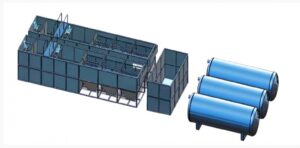RIVER WATER TREATMENT SYSTEM
WITH LAMELLA CLARIFIER

PRODUCT FEATURES
APPLICATIONS
These compact treatment systems, which includes pre-chlorination, coagulation-flocculation, lamella clarification, sand filtration and post-chlorination, can be used ideally in which require separation of suspended solids, leaving effluent clear for discharge.
The raw water will be collected from Iraqi rivers or other freshwater aquatic ecosystems, in order to produce potable water for several domestic purposes. (human consumption and other common uses). The treatment line of this water treatment plant includes:
The aim of flocculation-coagulation process is to remove the very thin particles, called colloids that are very important water constituents. They cause turbulence and a lot of times form stable colloidal suspensions
The aim of flocculation-coagulation process is to remove the very thin particles, called colloids that are very important water constituents. They cause turbulence and a lot of times form stable colloidal suspensions
The clarification of the raw water after chemical treatment is usually carried out by gravity sedimentation. In order to reduce the required sedimentation surface, it is very common to use lamellar sedimentation. Effectively, in contrast to conventional sedimentation, lamella sedimentation offers a high sedimentation surface when available terrain surface is reduced. After sedimentation, the treated water passes to a storage tank (regulation tank), from which the water is pumped using horizontal centrifugal pumps to pressure sand filters.
The main purpose of the sand filtration is to remove all small particles and flocks that have not been removed in clarification process, in order to obtain clear water ready for public supply.
In order to ensure the final quality of the treated water, post-chlorination is necessary operation; specially regarding to required residual free chlorine levels.
